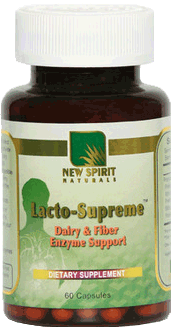
Lacto Supreme
A multi-functional proprietary blend of enzymes, prebiotics, and probiotics formulated to provide nutritional support to specifically improve the digestion of lactose (milk sugar), lipids, and the non-digestible sugars (oligosaccharides) from grains and legumes.
60 capsules
Retail $29.95 / Your Cost $22.46
|
 |
|
|

|

Lacto-Supreme is a multi-functional proprietary blend of enzymes, prebiotics, and probiotics including:
- Lactase--Breaks down lactose (milk sugar)
- Alpha-glactosidase--Facilitates digestion of beans, legumes, seeds, roots, soy products, and underground stems.
- Lipase-Breaks down fats found in most dairy products, nuts, oils, and meat.
- Protease-A blend of several different protein digesting enzymes.
- Amylase--A blend of enzymes which breaks down carbohydrates, starches, and sugars prevelant in potatoes, fruits, vegetables, and many snack foods.
- Hemicellulase--A mixture of enzymes which hydrolyze the indigestible components of plant fibers.
- Prebiotics (FOS)-- An all natural, GMO free source of shortchain fructooligosaccharides derived from beets, utilizing a patented process that incorporporates natural fermentation.
- Probiotics--Bacterial cultures that assist the body's naturally occurring gut flora to establish themselves. Intestinal microflora provide a variety of bioactive substances that enhance health, including short chain fatty acids (SCFA). They also help gently lower intestinal pH into a range that restricts the growth of potentially disease causing strains.
LactoSupreme when taken before a meal, can help prevent the uncomfortable symptoms of lactose or complex carbohydrate intolerance before they begin.
What is Lactose Intolerance
Some people do not have sufficient lactase to break down milk sugar.
Lactase is a digestive enzyme produced by the cells of the small intestine that breaks down lactose (a disaccharide found in milk) into monosaccharides glucose and galactose.
Primary lactase deficiency is a condition that develops over time for most people. After about 2 years of age, the body produces less lactase, although most people will not notice the symptoms until they are older.
Secondary lactase deficiency occurs upon injury to the small intestines, or with certain digestive diseases such as Celiac disease, Inflammatory Bowel Disease, and Crohn's.
Certain medications, such as antibiotics, can often bring on a temporary lactose intolerance.
Who Has Lactose Intolerance
Fifty million Americans are lactose intolerant. Certain ethnic
and racial populations are more widely effected than others.
As many as 75% of African Americans, Native Americans,
Jewish and Hispanic adults, and nearly 100% of Asian
American adults are lactose intolerant. Lactose intolerance
is least common among persons of Northern European descent.
Symptoms of Lactose Intolerance
When there is not enough lactase to digest the amount of
lactose consumed, the results can be distressing.
Common symptoms are nausea, cramps, bloating, gas, and
diarrhea, which begin about 30 minutes to two hours after
eating or drinking foods containing lactose.
Foods with Lactose
It is important for people with very low tolerance to know
about the many foods that may trigger digestive distress.
Although milk and foods made from milk are the primary
natural sources of lactose, small amounts may be added to
processed foods, including:
- bread and baked goods
- processed breakfast cereals
- instant potatoes, soups, & breakfast drinks
- margarine
- lunch meats
- salad dressings
- candies and other snacks
- mixes for pancakes, biscuits, cookies, etc.
Some so called non-dairy food products, such as powdered coffee creamer and whipped toppings, may also include ingredients that are derived from milk and, therefore, contain lactose. Foods labeled with ingredients, such as milk by-products, dry milk solids, and nonfat dry milk powder, indicate the presence of lactose.

